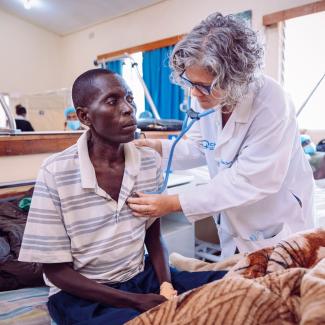Unmanned aerial vehicles (UAVs) are proving to be essential delivery vehicles for humanitarian aid and health supplies. According to the World Health Organization, approximately 2 billion people live beyond the reach of essential medicines and quality health care, and drones are helping resolve this last mile problem.
In Linyangwa, a remote village in Malawi, in 2022, newborn Philip Chunga went into respiratory distress after aspirating meconium during birth. The clinic texted the company Wingcopter, operating near Kasungu Hospital, to request a suction tube. About 20 minutes later, a drone arrived with the equipment and doctors were able to clear the baby's airways, saving his life. The aerial operation was part of the company's 2-year pilot program, Drone & Data Aid, to supplement ground transportation, which would have taken hours to reach the clinic.
In less than 10 years, drones, or unmanned aerial vehicles (UAVs), have transformed health care within sub-Saharan Africa, where they deliver life-saving medicine, vaccines, and blood to solve last mile hurdles. Despite enormous funding challenges and regulatory hurdles, a growing number of African countries benefit from UAVs.
Like other developing regions, many sub-Saharan African countries lack adequate infrastructure. Across the continent, approximately 600 million people live without electricity, clean water, or reliable roads, making a secure supply chain almost impossible to sustain. Along with the challenges associated with a largely rural population, those countries face the most devastating effects of climate change, including flooding and infectious disease outbreaks.
Just as many lower-income countries bypassed the expense of stringing telephone wires across the landscape by jumping to cellular phones, the cost of stable road networks and electrical grids could be avoided by leapfrogging to drone deliveries.
Securing Supply Chains with Drones
Aerial logistics companies are proving that a drone-based health-care supply chain is not only possible but also transformative. California-based Zipline International, with funding from GAVI and UPS Foundation, has operated in Ghana and Rwanda for several years, delivering blood, childhood vaccinations, COVID-19 vaccines, personal protective equipment (PPE), and family planning products to thousands of remote health-care facilities. The medical supplies are procured from local governments, which depend on international donor support for their budgets.
Aerial logistics companies are proving that a drone-based health-care supply chain is not only possible but also transformative
In 2016, Zipline became the national blood delivery service provider in Rwanda, where more than 80% of the population lives in rural areas. Today, Zipline's drones deliver 75% of the nation’s blood supply outside Kigali, flying predetermined routes and parachuting blood products.
Health-care workers simply place an order by a cell phone, and villages, separated from cities by hours-long journeys over dirt roads, can be reached in as few as 15 minutes by drone.
"We can cover hundreds of health facilities or other delivery drop points with a single distribution center," says Miki Sofer, senior vice president of Global Health Partnerships at Zipline.
In 2019, before the COVID-19 pandemic, Zipline partnered with Ghana's Ministry of Health and quickly became a critical link in the supply chain, delivering millions of doses of vaccines from six distribution hubs.
"COVID hit, and we were able to start supplying all these health facilities with routine vaccines which they couldn't access because of the lockdowns. We saw something like a tenfold surge in demand," says Sofer.
Measuring the Impact on Health Care
Few independent studies examining the impact of drone delivery have been published, but evidence of benefits is beginning to emerge.
One study from researchers at Wharton, not peer reviewed, reports a 51% reduction in deaths from postpartum hemorrhages in Rwanda as a result of Zipline-delivered blood. Postpartum hemorrhage is a leading cause of maternal death in sub-Saharan Africa, accounting for 30% to 50% of maternal deaths each year.
Another study, funded by the Bill & Melinda Gates Foundation, finds that over a three-month period clinics in Ghana had five fewer days without essential medical supplies including medicine, vaccines, and diagnostic tests after Zipline began operations.
In Rwanda, blood product expiration was reduced by approximately seven units each month after starting drone delivery, a 2022 Lancet study concludes.
Drone technology has advanced considerably since the 2010s, now offering improved connectivity and processing power enhanced by GPS receivers and machine learning. The drones used in Malawi and Rwanda typically carry a payload of 4 pounds (1.8 kilograms) and have a range of approximately 60 miles (96 kilometers). Governments are spared the expense of investing in widespread cold-chain storage because medications and vaccines can be transported quickly to remote clinics from distribution facilities. Additionally, drones produce minimal carbon emissions, unlike gas-powered ground vehicles.
"The drone is a powerful tool for governments to address the equity gap, improving access to primary health care to the underreached," says Olivier Defawe, director of Drones for Health for VillageReach, a Seattle-based nonprofit focused on building responsive health-care systems in remote communities.
Integration With National Health Systems
VillageReach's strategy includes connecting African ministries of health with private companies to establish drone delivery systems. Since 2016, VillageReach has led a multipartner group to collaborate and share resources among the UAV community. It is one of the leading organizations exploring the use of drones for public health, says Defawe. "We help governments and the private sector identify where drones make the most sense."
Establishing drone networks requires time, investment, and coordination with ministries of health and civil aviation authorities. VillageReach has helped start drone programs in Democratic Republic of Congo (DRC), Malawi, and Mozambique, and now works in more than 20 countries.
In DRC, VillageReach partnered with Swoop Aero, an Australian drone manufacturer, to provide UAVs, and SkyPorts, a British drone airline, to pilot the vehicles. Drone flights in Equateur Province began in July 2019 and have expanded since then to deliver tuberculosis, malaria, and Ebola vaccines to 25 remote facilities, many of which are traditionally reached by wooden canoes. "With a canoe, it takes two days. With drones, it takes less than an hour," says Freddy Nkosi, VillageReach's country director for DRC in Kinshasa.
Since 2021, the Malawi Ministry of Health has worked with VillageReach and Swoop Aero and deployed drones to transport material such as blood, lab samples, and vaccines across seven districts that are home to 1 million people.
To attract additional funding for drone systems, it is crucial to demonstrate a measurable improvement in health outcomes. Malawi is an ideal testing ground. One of the world's poorest nations, Malawi has some of the most challenging topography, with mountains, high plateaus, and the Great Rift Valley running through the center of the country. Most of its 20 million people live in rural areas, where access to the health-care system is limited. The prevalence of HIV, including mother-to-child transmission, is high and many cases go undetected.
A study of remote Malawi health facilities, sponsored by the U.S. Agency for International Development and currently in progress, has been designed to assess the impact of drone delivery on rate of missed vaccinations, number of days of supply stockout, and turnaround times for HIV and TB testing. A preliminary report states that this is the first-ever randomized control trial of medical drone deliveries. Of the 209 health facilities included in the study, approximately half will have access to drones; the remainder will rely on traditional ground transport.
If the data shows a significant impact, the partners hope to increase Malawi's drone coverage to 23 districts from the current seven, says Innocent Mainjeni, supply chain manager for VillageReach in Lilongwe.
The Drone Corridor and the Drone Academy
The United Nations Children's Fund (UNICEF) has been working to promote the use of UAVs and, in 2017, developed the Drone Corridor with the Malawi government. The more than 1,930 square mile (5,000 square kilometer) area is designated for nongovernmental organizations, companies, and universities to test pilot drones for services including aerial imaging, search and rescue operations, and transportation.
When health-care workers know a drone will arrive at the clinic's front door on demand, they are able to work more efficiently
Building a drone network requires a local workforce with technical expertise, including pilot licenses. To meet the demand, the Malawi University of Science and Technology developed a drone academy using a curriculum created by Virginia Tech engineering professor Kevin Kochersberger. Since 2020, approximately 1,300 pilots have graduated from the 11-week course, many of whom have gone to work for drone companies across the continent.
"The course is built around what's required for the Malawi drone pilot's license, which is to understand an element of radio telephony," says Kochersberger. Although Malawi has embraced the technology, new drone operation is highly regulated by the Department of Civil Aviation.
"It really goes beyond anything that's required in the United States," he says.
Although the aviation authority has not yet formalized it regulations, it has developed ad hoc requirements for drone operators. Malawi drone pilots are required to demonstrate their skills in a practical flight assessment, take a radio operators course, and pass a medical exam. In the United States, pilots are required to follow Federal Aviation Administration rules and pass a written exam before flying a drone.
Building Trust
Until recently, solving the last mile problem in remote regions with limited resources and formidable geography was an insurmountable challenge. Evidence is growing, however, that government investment in aerial logistics improves community health care. VillageReach hopes that if more government sectors incorporate UAVs into their standard functions, the technology could evolve from being a short-term project funded by international donors to a routine mode of transportation with a secure annual budget.
Drones convey more than just cargo, says Defawe. They also affect the behavior of recipients. When health-care workers know a drone will arrive at the clinic's front door on demand, they are able to work more efficiently. They no longer have to scramble to obtain essential supplies. As people become aware that the clinic is consistently stocked, more will come seeking services.
"There is a shift of trust in the health system," says Defawe.


